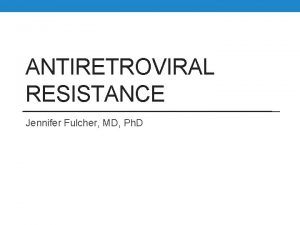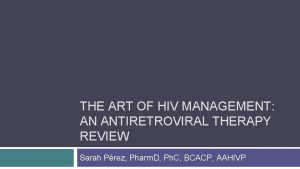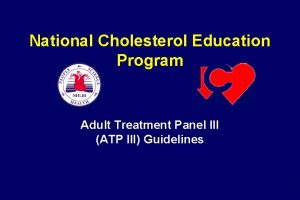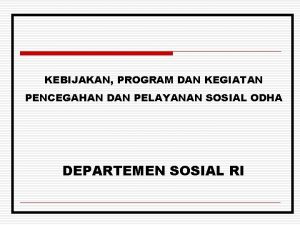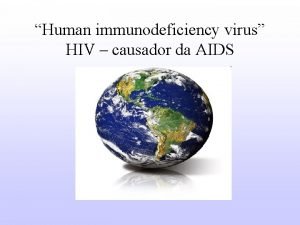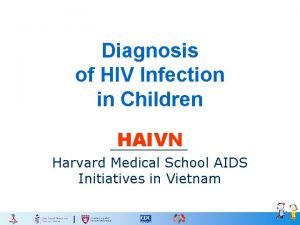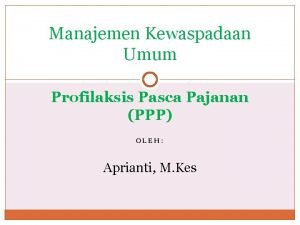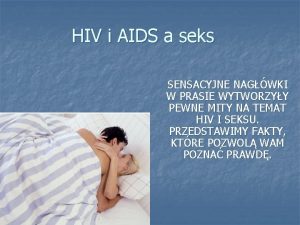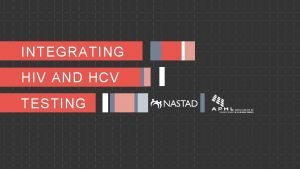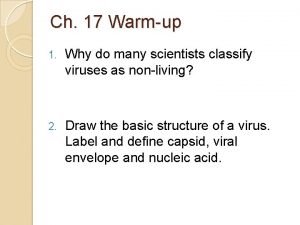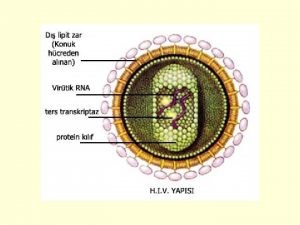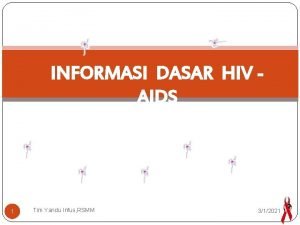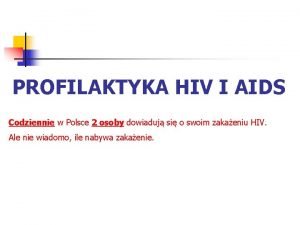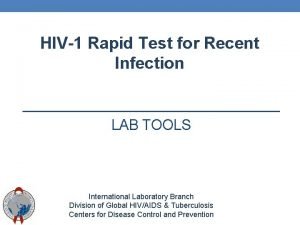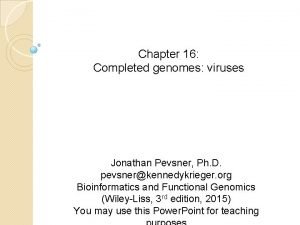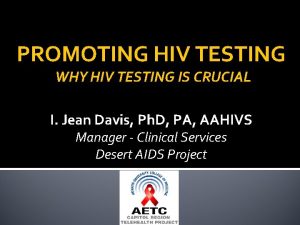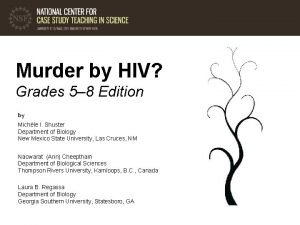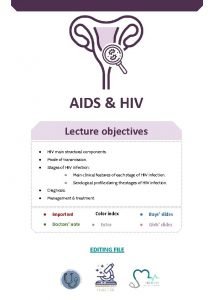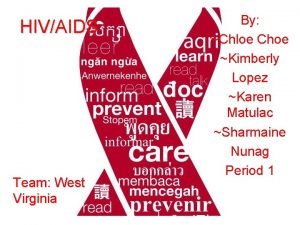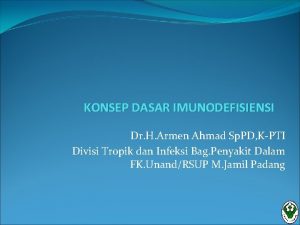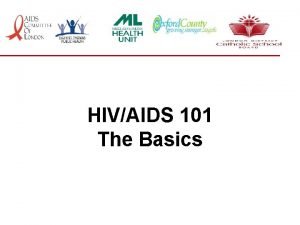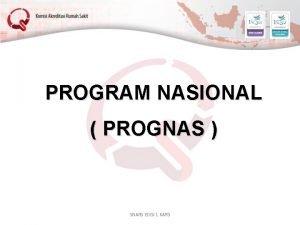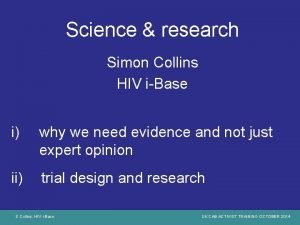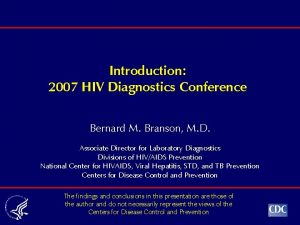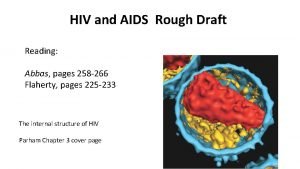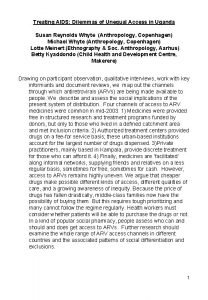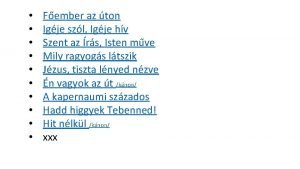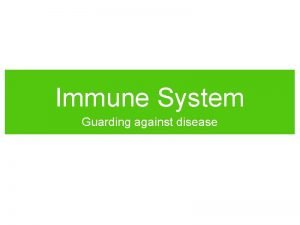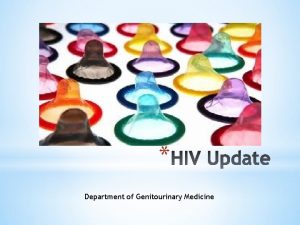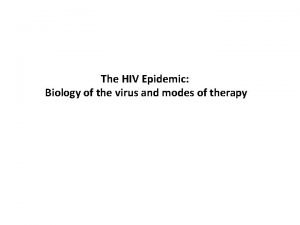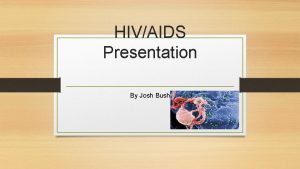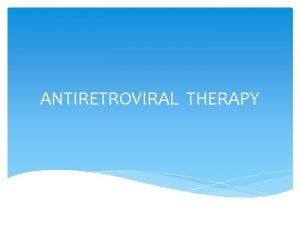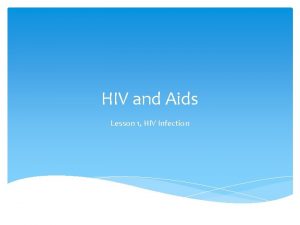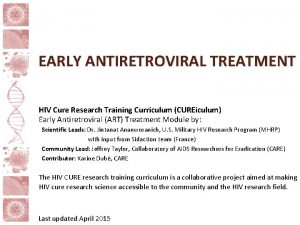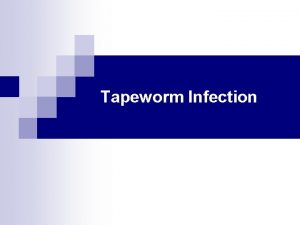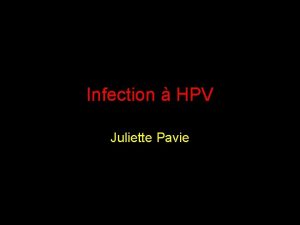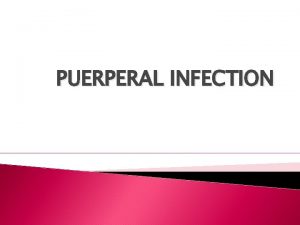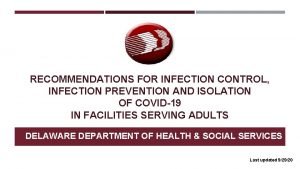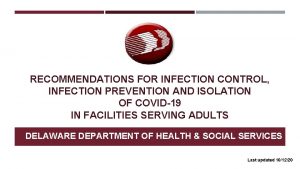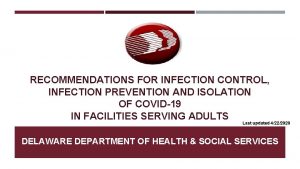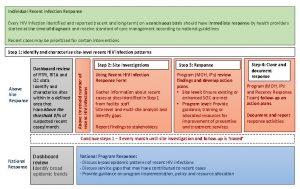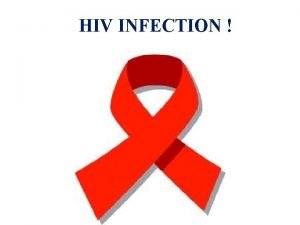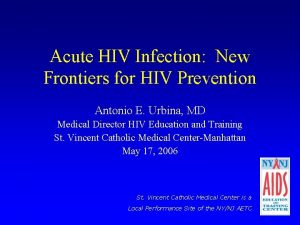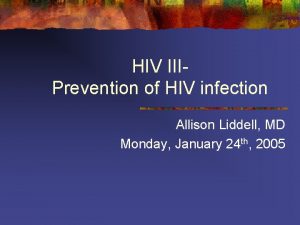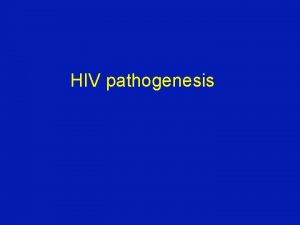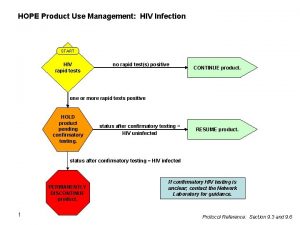Antiretroviral Treatment of Adult HIV Infection 2014 Recommendations









































- Slides: 41

Antiretroviral Treatment of Adult HIV Infection: 2014 Recommendations of the International Antiviral Society USA Panel Huldrych F. Günthard, MD; Judith A. Aberg, MD; Joseph J. Eron, MD; Jennifer F. Hoy, MBBS, FRACP; Amalio Telenti, MD, Ph. D; Constance A. Benson, MD; David M. Burger, Pharm. D, Ph. D; Pedro Cahn, MD, Ph. D; Joel E. Gallant, MD, MPH; Marshall J. Glesby, MD, Ph. D; Peter Reiss, MD, Ph. D; Michael S. Saag, MD; David L. Thomas, MD, MPH; Donna M. Jacobsen, BS; Paul A. Volberding, MD Günthard et al, JAMA, 2014.

IAS USA Antiretroviral Guidelines 1996 – 2014 Slide 2 of 41 Günthard et al, JAMA, 2014.

2014 IAS USA Antiretroviral Guidelines Authors Huldrych F. Günthard, MD Judith A. Aberg, MD Joseph J. Eron, MD Jennifer F. Hoy, MBBS, FRACP Amalio Telenti, MD, Ph. D Constance A. Benson, MD David M. Burger, Pharm. D, Ph. D Pedro Cahn, MD, Ph. D Slide 3 of 41 Günthard et al, JAMA, 2014. Joel E. Gallant, MD, MPH Marshall J. Glesby, MD, Ph. D Peter Reiss, MD, Ph. D Michael S. Saag, MD David L. Thomas, MD, MPH Donna M. Jacobsen, BS Paul A. Volberding, MD

IAS USA Antiretroviral Guidelines • Authored by 14 -member, international (5 countries) panel o Members receive no compensation and do not participate in industry promotional activities while on the panel • Based upon pathogenesis- and evidence-based individualization • • of therapy Primarily for clinicians in highly resourced settings; however, principles are universally applicable Reviewed data published or presented 7/12 – 6/14 Rated on strength of recommendations and quality of evidence Focused on when to start therapy; pre-exposure prophylaxis; what to start; patient monitoring; treatment-experienced patients Slide 4 of 41 Günthard et al, JAMA, 2014.

Rationale for Issuing Revised Guidelines • Evaluate new data showing all patients may benefit from ART • Evaluate new data that ART reduces likelihood of HIV transmission • Consider issues of relevance to persons with hepatic, renal, or cardiovascular comorbidities; opportunistic infections; or at high risk for HIV transmission Slide 5 of 41 Günthard et al, JAMA, 2014.

Methods • Systematic Literature Review of Pub. Med and EMBASE • Hand searches for newly published reports and scientific abstracts, safety reports • ARV manufacturers submitted lists of recent publications or abstracts meeting established criteria • Data not published or presented in a peer-reviewed setting were not considered • Drugs, formulations, combinations considered: o o o Approved by regulatory agencies (eg, FDA) Available in expanded access program Submitted for regulatory approval (ie, in late development stages) Slide 6 of 41 Günthard et al, JAMA, 2014.

When to Start IAS-USA RECOMMENDATIONS 2014 Günthard et al, JAMA, 2014.

When to Start ART: IAS-USA Recommendations 2014 ART is recommended for treatment of HIV infection and prevention of transmission of HIV regardless of CD 4 cell count (AIa-BIII) Lack of demonstrated harm with early initiation, cost effective, clinically beneficial ART is cost-effective in resource-rich and –poor countries In next 4 years, more than 20 drugs are expected to become available as generics Slide 8 of 41 Günthard et al, JAMA, 2014.

When to Start ART: IAS-USA Recommendations 2014 Offer ART to all patients with acute or early infection; start as soon as possible to maximize benefit Reduced proviral DNA and plasma viral load, lower viral set point, robust immune reconstitution, and CD 4 cell counts greater than 900/µL Planned discontinuation after specific duration is not recommended except in research settings Slide 9 of 41 Günthard et al, JAMA, 2014.

When to Start ART: IAS-USA Recommendations 2014 ART is recommended regardless of CD 4 cell count The patient must be willing and ready to initiate therapy; patients not ready to start ART should remain in clinical care, with regular monitoring and ongoing discussion about need for ART The strength of recommendations and evidence increase as CD 4 cell counts decrease and in the presence of certain conditions Slide 10 of 41 Günthard et al, JAMA, 2014.

When to Start ART: IAS-USA Recommendations 2014 Strength of recommendation and quality of evidence varies According to CD 4 cell count: ¡ ¡ CD 4 cell counts <500 µL(AIa) CD 4 cell counts of >500 µL (BIII) According to clinical condition with CD 4 cell counts of >500 µL: ¡ ¡ ¡ Pregnancy (AIa) Chronic HBV co-infection (AIIa) HIV-associated nephropathy (AIIa) Slide 11 of 41 Günthard et al, JAMA, 2014.

When to Start ART: IAS-USA Recommendations 2014 According to clinical condition (cont’d): ¡ Acute phase of primary HIV infection, regardless of symptoms (BIII) ¡ Preferably within first 2 weeks of diagnosis of opportunistic infections (AIa) ¡ Early in treatment for cryptococcal meningitis, when expert management of both HIV and cryptococcal infection is available (BIII) Slide 12 of 41 Günthard et al, JAMA, 2014.

What Treatment to Start IAS-USA RECOMMENDATIONS 2014 Günthard et al, JAMA, 2014.

What Treatment to Start: IAS-USA Recommendations 2014 ART is considered lifelong; sustained viral suppression is foundation for immune recovery, optimal health, and prevention of resistance and transmission. Maximize adherence and minimize toxicity: Goal is to treat with effective, well-tolerated therapy, with limited drug interactions and effects on comorbid conditions. Base selection on baseline resistance testing and patient characteristics and preferences Slide 14 of 41 Günthard et al, JAMA, 2014.

Recommended Initial ART Regimens: INSTI plus 2 n. RTIs INSTI plus 2 n. RTI Combinations DTG plus TDF/FTC Rating Comments AIa DTG plus ABC/3 TC AIa EVG/cobi/TDF/FTC AIa RAL plus TDF/FTC AIa DTG is dosed once daily. Associated with modest increases in creatinine level due to inhibition of creatinine secretion No evidence that ABC/3 TC performs less well at HIV-1 RNA levels >100 000 copies/m. L when given with DTG. A fixed-dose combination is in late-stage development. Once-daily fixed-dose combination. Cobi is associated with modest increases in creatinine level; has drug interactions similar to RTV. RAL is taken twice daily. Slide 15 of 41 Günthard et al, JAMA, 2014.

Recommended Initial ART Regimens: NNRTI plus 2 n. RTIs NNRTI plus 2 n. RTI Combinations Rating Comments EFV/TDF/FTC AIa EFV central nervous symptoms may persist beyond 2 -4 weeks, but is no longer contraindicated for use in pregnant women EFV plus ABC/3 TC AIa EFV central nervous symptoms may persist beyond 2 -4 weeks, but is no longer contraindicated for use in pregnant women RPV/TDF/FTC AIa Once-daily fixed-dose combination. RPV-based therapy is not recommended in patients with baseline HIV-1 RNA levels > 100 000 copies/m. L Slide 16 of 41 Günthard et al, JAMA, 2014.

Recommended Initial ART Regimens: RTV -boosted PI plus 2 n. RTIs RTV-boosted PI plus 2 Rating NRTI Combinations Comments ATV plus TDF/FTC AIa ATV is associated with nephrolithiasis, cholelithiasis, and chronic kidney injury. ATV plus ABC/3 TC AIa ATV is associated with nephrolithiasis, cholelithiasis, and chronic kidney injury. DRV plus TDF/FTC AIa During initial therapy, 800 mg of DRV is given once daily with 100 mg of RTV given once daily Slide 17 of 41 Günthard et al, JAMA, 2014.

Alternatives to Recommended Initial Regimens Type of Regimen Comments ISTI plus 2 n. RTIs Alternative ARV Drug Rating Combinations RAL plus ABC/3 TC BI 1 NNRTI plus 2 n. RTIs NVP plus 2 n. RTIs BIa RPV plus ABC/3 TC AIa Severe hepatotoxicity may occur in initial therapy when CD 4 cell count is >250 µ/L in women and >400 µ/L in men. Severe rash is more common than with other NNRTIs. RPV-based therapy is not recommended in patients with baseline HIV-1 RNA levels >100 000 copies m/L. Slide 18 of 41 Günthard et al, JAMA, 2014. No evidence that ABC/3 TC performs less well at HIV-1 RNA levels >100 000 copies/m. L when taken with RAL.

Alternatives to Recommended Initial Regimens, cont’d Type of Regimen PI plus 2 n. RTIs Alternative ARV Drug Combinations ATV/cobi with 2 n. RTIs Slide 19 of 41 Günthard et al, JAMA, 2014. Rating Comments BIa ATV plus cobi as a fixed-dose combination achieves ATV levels similar to those with RTV boosting. As separate agents, they were noninferior to RTV-boosted ATV, both in combination with TDF /FTC.

Alternatives to Recommended Initial Regimens, cont’d Protease inhibitor plus 2 nucleoside reverse transcriptase inhibitors, cont’d. DRV/cobi with 2 n. RTIs BIII DRV plus cobi as a fixed-dose combination achieves DRV levels similar to those with RTV boosting. DRV plus ABC/3 TC BIb Comparative clinical data from a subset of patients from a single randomized study. LPV fixed-dose BIa Main advantage is fixed-dose combination with 2 n. RTIs combination. May have increased cardiovascular risk and be less tolerable than recommended options. Slide 20 of 41 Günthard et al, JAMA, 2014.

Alternatives to Recommended Initial Regimens, cont’d Type of Regimen Rating Comments n. RTIs Alternative ARV Drug Combinations DRV plus RAL LPV plus 3 TC BIa LPV plus RAL BIa Slide 21 of 41 Günthard et al, JAMA, 2014. BIb RAL taken twice daily, RTV-boosted DRV taken once daily. Less effective at CD 4 cell counts of <200 µ/L and possibly HIV-1 RNA levels >100 000 copies/m. L. Single study; comparator n. RTIs included ZDV (53. 9%), TDF (36. 6%), and ABC (9. 4%), each with 3 TC. Both medications taken twice daily; single study with relatively small sample size and low baseline plasma HIV-1 RNA level.

Recommendations for Initial Treatment in the Settings of Specific Conditions Pregnancy: ART should be initiated in all HIV-infected women who become pregnant; ZDV/3 TC plus either RTV-boosted LPV or RTV-boosted ATV are preferred. Comorbid diseases: Choice of regimen is influenced by chronic and acute comorbidities; assess for exacerbation of comorbid conditions, negative clinical outcomes, increased ARV toxicity, drug interactions with ARV agents. Slide 22 of 41 Günthard et al, JAMA, 2014.

Recommendations for Initial Treatment in the Settings of Specific Conditions, cont’d. In patients with or at high risk of cardiovascular disease, avoiding use of ABC, RTV-boosted LPV, or RTV-boosted Fos-APV might be considered. In patients with reduced renal function, TDF should be avoided, especially in combination with a boosted PI. Given the increased risk of fragility fractures, it may be prudent to avoid TDF as part of initial therapy in postmenopausal women. Slide 23 of 41 Günthard et al, JAMA, 2014.

Recommendations for Initial Treatment in the Settings of Specific Conditions, cont’d. The recommended initial ART regimen in the setting of rifampin based TB treatment is 600 mg EFV plus 2 NRTIs; if EFV cannot be used, rifabutin-based therapy with a boosted PI plus 2 NRTIs is an alternative. A 3 -month, once-weekly regimen of isoniazid with rifapentine for treatment of latent TB infection is as effective as 9 months of isoniazid alone and is equally effective in HIV-infected individuals. No data yet on use of bedaquiline for treatment of multidrugresistant TB in HIV-infected patients receiving ART; expert consultation is recommended. Slide 24 of 41 Günthard et al, JAMA, 2014.

Recommendations for Initial Treatment in the Settings of Specific Conditions, cont’d. The ART regimen for HIV- and HBV coinfected persons should include TDF and FTC or 3 TC as the NRTI background. DTG- or RAL-based regimens are recommended for patients receiving anticancer or immunosuppressive drugs. In the setting of HCV and HIV co-infection, consult guidance from the AASLD, IDSA, or IAS-USA. Slide 25 of 41 Günthard et al, JAMA, 2014.

Monitoring IAS-USA RECOMMENDATIONS 2014 Günthard et al, JAMA, 2014.

Recommendations for Monitoring Upon Initiation of or Change in ART HIV-1 RNA levels: Monitor at approximately 4 weeks after treatment initiation or change; Monitor every 3 months to confirm suppression of viremia to below the limitation of quantification of sensitive commercial assays (AIa). CD 4 cell count: Monitor every 3 months after initiation of ART, especially for patients with cell counts of <200 µL; results will determine need to initiate or discontinue primary opportunistic infection prophylaxis (BIII) Slide 27 of 41 Günthard et al, JAMA, 2014.

Recommendations for Ongoing Monitor at intervals of ≤ 6 months if viral load is suppressed for 1 year, CD 4 cell count is stable at ≥ 350 µL, and patient’s adherence is dependable (CIII). Monitoring is optional if viral load is suppressed consistently for more than 2 years, CD 4 cell counts are persistently >500/µL, except in setting of virologic failure or immunosuppressive treatments or conditions (CIII). If HIV-1 RNA level is detectable (>50 copies/m. L) during therapy, confirm within 4 weeks before making changes (BIII). If HIV-1 RNA level is greater than 200 copies/m. L during therapy, evaluate factors leading to failure and consider switch in ART (AIIa). Slide 28 of 41 Günthard et al, JAMA, 2014.

Recommendations for Ongoing Monitoring, cont’d. Perform baseline genotypic testing for resistance in all treatment-naive patients (AIIa) and in cases of confirmed virologic failure (AIa). Routine therapeutic drug monitoring is not recommended, though selected patients may benefit (BIII). Laboratory monitoring for ART toxicity is recommended, guided by presence or absence of comorbidities and by components of the regimen. Slide 29 of 41 Günthard et al, JAMA, 2014.

Changing ART Regimens IAS-USA RECOMMENDATIONS 2014 Günthard et al, JAMA, 2014.

Recommendations for Changing the ART Regimen in Treatment-Experienced Patients Design of a new regimen should consider previous ART exposure, previous resistance profile, and history of intolerance or toxic effects (AIIa). Depending on the resistance profile, viral tropism, and options available for patients with multidrug resistance, inclusion of a boosted PI and agents from newer drug classes (eg, an INSTI or maraviroc) should be considered (AIa). Monotherapy with a boosted PI is not recommended when other options are available (AIa). Slide 31 of 41 Günthard et al, JAMA, 2014.

Recommendations for Changing the ART Regimen in Treatment-Experienced Patients, cont’d. Maintenance of virologic suppression is paramount when switching the regimen to improve tolerability, reduce toxicity, and improve convenience (AIa). Switching or regimen simplification in virologically suppressed individuals is generally safe if prior treatment and resistance profile are considered. Full activity of the NRTIs is important when switching from a RTV-boosted to a drug with a lower barrier to resistance (AIa). Slide 32 of 41 Günthard et al, JAMA, 2014.

Summary of Selected New Recommendations AND THOSE FOR WHICH THE STRENGTH OR QUALITY OF EVIDENCE HAS CHANGED SUBSTANTIALLY IAS-USA RECOMMENDATIONS 2014 Günthard et al, JAMA, 2014.

Summary of Selected New Recommendations and Those for Which the Strength or Quality of Evidence Has Changed Substantially Changes in Recommendations for When to Start ART: ART is recommended for the treatment of HIV infection and prevention of transmission regardless of CD 4 cell count (AIa-BIII). ART should be started as soon as possible, preferably within the first 2 weeks of diagnosis, in patients with opportunistic infections (AIa) and other opportunistic diseases and AIDS-defining illnesses (AIa-BIII). Optimal timing of ART initiation in patients with cryptococcal meningitis is less certain, but early start should be considered where expert management for both cryptococcal and HIV-1 infection is available (BIII). Slide 34 of 41 Günthard et al, JAMA, 2014.

Summary of Selected New Recommendations and Those for Which the Strength or Quality of Evidence Has Changed Substantially, cont’d. Changes in Recommendations for What Treatment to Start: DTG-based regimens and co-formulated EVG/cobi/TDF/FTC have been added to the list of recommended initial regimens (AIa). Co-formulated RPV/TDF/FTC has been added as an initial recommended regimen in patients with HIV-1 RNA levels <100, 000 copies/m. L (AIa). RAL plus ABC/3 TC has been added as an alternative initial regimen (BIa). ATV/cobi plus 2 NRTIs was added as an alternative initial regimen (BIa). Slide 35 of 41 Günthard et al, JAMA, 2014.

Summary of Selected New Recommendations and Those for Which the Strength or Quality of Evidence Has Changed Substantially, cont’d. Changes in Recommendations for What Treatment to Start, cont’d: DRV/cobi plus 2 NRTIs was added as an alternative initial regimen (BIII). RTV-boosted DRV plus ABC/3 TC was added as an alternative initial regimen (BIb). RTV-boosted DRV plus RAL has been added as NRTI-sparing alternative regimen only to be used in certain circumstances (BIb) RTV-boosted LPV plus 3 TC has been added as an NRTI-limiting alternative regimen only to be used in certain circumstances (BIb). Slide 36 of 41 Günthard et al, JAMA, 2014.

Summary of Selected New Recommendations and Those for Which the Strength or Quality of Evidence Has Changed Substantially, cont’d. Changes in Recommendations for Monitoring: HIV-1 RNA level should be monitored approximately 4 weeks after treatment is initiated or changed, and then every 3 months to confirm suppression of viremia below the limit of quantification of sensitive commercial assays (AIa). Once viral load has been suppressed consistently for >2 years and CD 4 cell counts are consistently >500/µL, monitoring CD 4 cell counts is optional unless virologic failure occurs or there are intercurrent immunosuppressive treatments or conditions (CIII). Slide 37 of 41 Günthard et al, JAMA, 2014.

Summary of Selected New Recommendations and Those for Which the Strength or Quality of Evidence Has Changed Substantially, cont’d. HIV-1 RNA level >200 copies/m. L should prompt evaluation of factors leading to failure and consideration of switching ART (AIIa). Laboratory monitoring for ART toxicity is recommended. In the absence of new abnormalities after week 16 of treatment, the frequency of monitoring—generally between 3– 6 months—should be guided by the presence or absence of comorbidities and by the components of the regimen (CIII). Slide 38 of 41 Günthard et al, JAMA, 2014.

Summary of Selected New Recommendations and Those for Which the Strength or Quality of Evidence Has Changed Substantially, cont’d. Changes in Recommendations for Treatment-Experienced Patients Depending on resistance, viral tropism, and available options, inclusion of a boosted PI and agents from newer drug classes should be considered in patients with multidrug resistance (AIa). Maintenance of virologic suppression is paramount when switching a regimen to improve tolerability, reduce toxicity, and improve convenience (AIa). Switching or regimen simplification in virologically suppressed individuals is generally safe if prior treatment and resistance profile are considered. Full activity of the NRTIs is important when switching from a RTV-boosted to a drug with a lower barrier to resistance (AIa). Slide 39 of 41 Günthard et al, JAMA, 2014.

Conclusions IAS-USA RECOMMENDATIONS 2014 Günthard et al, JAMA, 2014.

Conclusions Early, intensified, widespread, and uninterrupted treatment is best option for controlling the epidemic. To exploit full potential of ART, greater efforts are needed to diagnose and treat infection as early as possible, and particularly acute and recent infection, which is a major driver of the epidemic. New, less toxic drugs with convenient dosing facilitates widespread acceptance of early ART. New strategies are needed to reduce stigmatization and discrimination that delay care. Slide 41 of 41 Günthard et al, JAMA, 2014.
 Antiretroviral
Antiretroviral Antiretroviral
Antiretroviral Adult treatment panel iii
Adult treatment panel iii Kasus hiv aids
Kasus hiv aids Hiv
Hiv Hiv meaning
Hiv meaning Profilaksis pasca pajanan
Profilaksis pasca pajanan Procentowe ryzyko zakażenia hiv
Procentowe ryzyko zakażenia hiv Hiv test window period
Hiv test window period Hiv retrovirus
Hiv retrovirus Hiv pencere dönemi
Hiv pencere dönemi Stadium hiv menurut who
Stadium hiv menurut who Stakeholders in hiv prevention
Stakeholders in hiv prevention Triệu chứng nhiễm hiv
Triệu chứng nhiễm hiv Choroby wskaznikowe aids
Choroby wskaznikowe aids Asante hiv-1 rapid recency assay
Asante hiv-1 rapid recency assay Hiv siv
Hiv siv Negative hiv test result
Negative hiv test result Murder by hiv
Murder by hiv Most complex characters evolve
Most complex characters evolve Incubation period of hiv
Incubation period of hiv Symptoms of hiv
Symptoms of hiv Aids symptoms
Aids symptoms Hiv risk factors
Hiv risk factors Global hiv prevention coalition
Global hiv prevention coalition Stadium hiv
Stadium hiv What does hiv stand
What does hiv stand Prognas akreditasi
Prognas akreditasi Simon collins hiv
Simon collins hiv A bacterial std that usually affects mucous membranes
A bacterial std that usually affects mucous membranes Procentowe ryzyko zakażenia hiv
Procentowe ryzyko zakażenia hiv Hiv diagnostics conference
Hiv diagnostics conference Hiv life cycle
Hiv life cycle Hiv cure
Hiv cure Főember az úton kocsi rázza
Főember az úton kocsi rázza Dot
Dot Hiv
Hiv Hiv lifecycle
Hiv lifecycle Retrovrus
Retrovrus Hiv treatments
Hiv treatments Hiv reverse transcription
Hiv reverse transcription Syptoms of hiv
Syptoms of hiv
